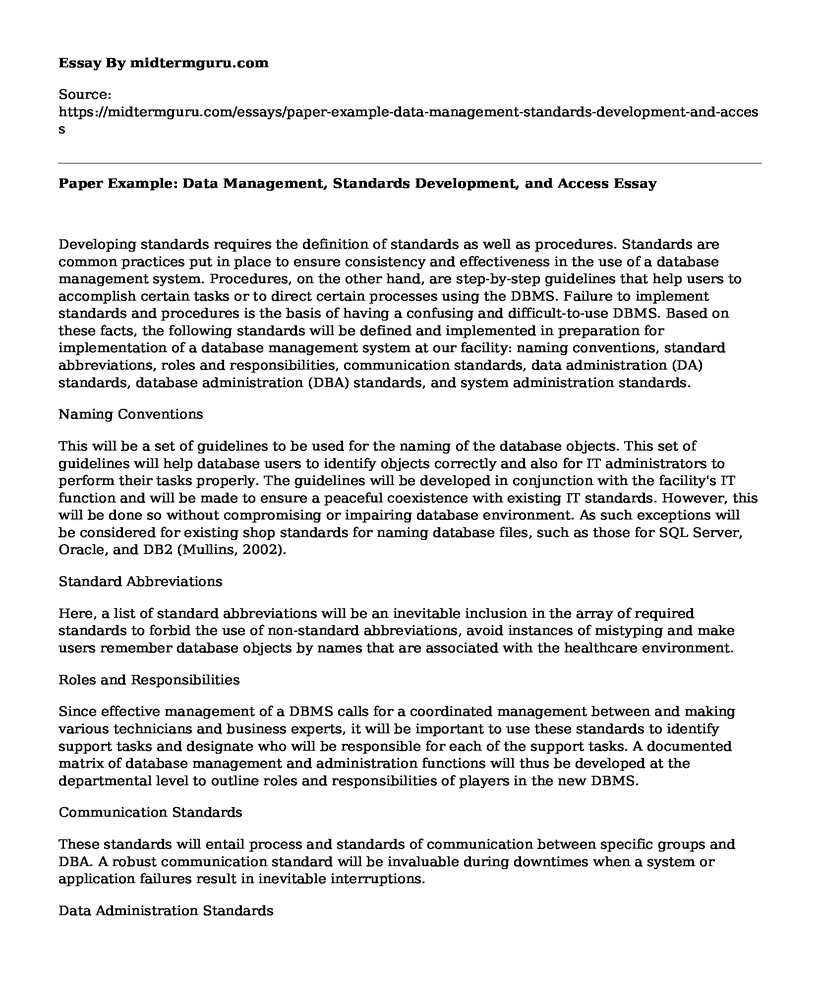Developing standards requires the definition of standards as well as procedures. Standards are common practices put in place to ensure consistency and effectiveness in the use of a database management system. Procedures, on the other hand, are step-by-step guidelines that help users to accomplish certain tasks or to direct certain processes using the DBMS. Failure to implement standards and procedures is the basis of having a confusing and difficult-to-use DBMS. Based on these facts, the following standards will be defined and implemented in preparation for implementation of a database management system at our facility: naming conventions, standard abbreviations, roles and responsibilities, communication standards, data administration (DA) standards, database administration (DBA) standards, and system administration standards.
Naming Conventions
This will be a set of guidelines to be used for the naming of the database objects. This set of guidelines will help database users to identify objects correctly and also for IT administrators to perform their tasks properly. The guidelines will be developed in conjunction with the facility's IT function and will be made to ensure a peaceful coexistence with existing IT standards. However, this will be done so without compromising or impairing database environment. As such exceptions will be considered for existing shop standards for naming database files, such as those for SQL Server, Oracle, and DB2 (Mullins, 2002).
Standard Abbreviations
Here, a list of standard abbreviations will be an inevitable inclusion in the array of required standards to forbid the use of non-standard abbreviations, avoid instances of mistyping and make users remember database objects by names that are associated with the healthcare environment.
Roles and Responsibilities
Since effective management of a DBMS calls for a coordinated management between and making various technicians and business experts, it will be important to use these standards to identify support tasks and designate who will be responsible for each of the support tasks. A documented matrix of database management and administration functions will thus be developed at the departmental level to outline roles and responsibilities of players in the new DBMS.
Communication Standards
These standards will entail process and standards of communication between specific groups and DBA. A robust communication standard will be invaluable during downtimes when a system or application failures result in inevitable interruptions.
Data Administration Standards
These set of standards will be the most important to our DA group and will include guidelines on their job role. More specifically, these standards will include:
Statement regarding organization's overall policy on data and its level of significance;
Rules for data creation, ownership, and stewardship;
Metadata management policy;
Conceptual and logical data modeling and analysis guidelines; and
Rules regarding communication between data administration (DA) and database administration (DBA) for effective creation and usage of the database management system (Mullins, 2002).
Dba Standards
These standards will guide efforts to support specific approaches in support of the database environment. These will include guidelines on how to communicate about the need to make adjustments to the database, what database objects are to be manipulated, and why such a move is necessary. This will also encompass other areas such as guidelines on monitoring, reporting, and correcting database system functioning.
System Administration Standards
Finally, because our facility will operate system administration (SA) and database administration (DBA) separately, it is a requirement that system administration standards are developed to provide DBMS installation and testing procedures, upgrade policies and procedures, maintenance policies, interface considerations and DBMS storage, usage, and monitoring (Mullins, 2002).
Steps to Initialize DBMS System
The following steps are essential in initializing the new DBMS at the health facility:
Assessing hardware requirements such as CPU version and minimum processor speed; supported hardware models, and different flavors of DBMS to choose from including those that support parallel processing, pervasive computing, data warehousing, and mobile computing needs;
Assessing storage requirements depending on system catalog or data dictionary size, storage to support distributed computing or storage of management tools. Other considerations here will include the size of log files, the must-have start-up or control files, default database, system dump, as well as the size of error-processing files.
Assessing memory requirements. This will depend on the facility's buffer pool or data cache size, which is needed to reduce I/O requests, program cache to support such features as the handling of lock requests, and facilitation of distributed data requests, sorting data and optimizing database processes to improve efficiency and cost-effectiveness of the system.
Configuring the DBMS. This is the most important step that will involve making the system and its parts interoperable. This will ensure that the system is not compromised because of use of software or devices from different vendors in a single system.
Connecting the new DBMS to supporting infrastructure software. Supporting software includes the operating systems and system utilities that are in use and employees of the facility are well-conversant with.
Verifying system installation. This step is the final one where system checks and testing procedures are implemented to confirm that the system is working and is ready for use by the facility. Any failures are noted, and proper procedures are taken to correct such failures (Mullins, 2002).
Reference
Mullins, C. (2002). Database administration. Boston: Addison-Wesley.
Cite this page
Paper Example: Data Management, Standards Development, and Access. (2021, May 24). Retrieved from https://midtermguru.com/essays/paper-example-data-management-standards-development-and-access
If you are the original author of this essay and no longer wish to have it published on the midtermguru.com website, please click below to request its removal:
- Health Information Technology and Electronic Medical Record
- Essay on Mitigating the Factors for the Client Service for Netware
- Project Failure Reflection Blog - Paper Example
- Background of the Kinetic Monte Carlo Method and a Description of the Catalyst Method
- Internet Impact on Youth Culture - Essay Example
- Essay on Effects of Looking Down at Gadgets
- Data Communication - Essay Sample







